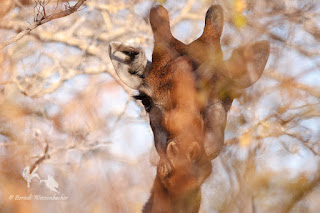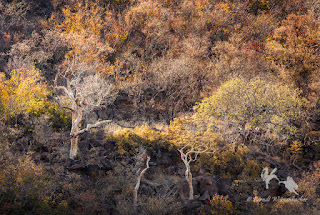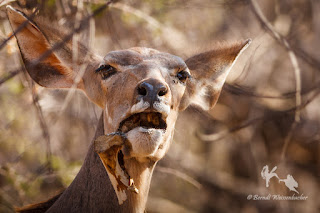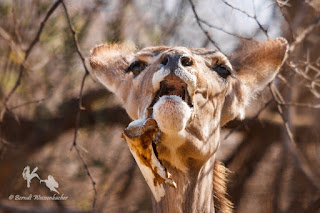Marakele National Park (in the Limpopo Province
of South Africa) straddles the foothills of the Waterberg Plateau. The western
part of the park is rather flat and covered by the typical lowland bushveld
found in this part of the country; the eastern part incorporates the first hills
and lower mountains of the Waterberg itself. I was visiting this gem of a park
in August (midwinter in the southern hemisphere) and the time when the bushveld
is compressed to a palette of yellows, browns and greys.
In July and August of the year before my visit,
several people had reported sightings of aardvark in the early and late hours
of the day. Members of my extended family had even returned with cell phone
videos of an aardvark traipsing through grassland in splendid morning light. I
had not been able to visit Mokala at that time, but I reckoned that a visit the
following year might afford me an opportunity to photograph these nocturnal
beasts too. No luck! No one, not even the staff, had seen any aardvark during
the day again since the previous year.
I never rely solely on one photographic
objective. I have never understood the mania of people desperately needing to
spot particular species in any wilderness environment. The African bush and
landscape form an integral whole of sights, sounds, perfumes, textures and
tastes (if, like me, you will stuff wild fruit, grass stems and leaves into
your mouth). (Please do not simply taste
any vegetable or animal matter. Inform yourself beforehand whether it is safe
to do so.) To me, the entirety of the bushveld makes up the experience, not
just isolated sightings of a few species. So, in the absence of aardvark, I
enjoyed the challenge of capturing the bushveld in its magnificent winter dress.
Wildlife photography is very hard work. The spectacular
images presented by photographers make up only a miniscule fraction of time, a
few seconds at most, of a year's worth of searching. For several reasons my own
trip this time around was proving to be quite a challenge – nothing seemed to
work out, nothing seemed to ping into place.
One afternoon, as I was leaving the campsite to
spend the late afternoon hours hunting shots, I spotted a lone kudu cow in a
dense thicket. She was truly stuck in the thick of it and the light was still
quite harsh. Therefore, I trundled past at slow speed so that I would not spook
her. I had already moved passed this kudu cow and cast a last glance at her. Something
was up; she was chewing on something very large, definitely not a bunch of
leaves. I drove on for another 25 metres and turned around for another look. As
I approached very slowly, the kudu cow moved into an even denser part of the
thicket.
Through the branches and leaves, I could see
that the kudu was chewing on a knee-joint of some long-dead animal*. She kept on tossing her head back in
order to change the grip of her teeth on this unusual fare. She had started frothing
from the corners of the mouth, so intense were her efforts at chewing the
sinews and bone of her extraordinary meal.
The light was not ideal and leaves, twigs and
branches blocked the view; and yet I kept on taking photographs. The actions of
the kudu cow, chewing on a piece of another kudu, as it turned out, kept me engrossed.
(Later, I located the remainder of the timeworn carcass some 20 metres down the
road and confirmed my inklings about the species that had provided this
extraordinary meal.) Somehow, the harsh lighting and the chaos of branches augmented
my uncanny experience of this incredible sighting of a ‘Kudu Cannibal’.
* I have written previously about osteophagy (the eating of bone by
animals) and the possible reasons why this behaviour is relatively common among
wild herbivores.





Hi Bernd, this may sound far fetched, but it is possible that the cow is mourning the death of a herd ( family) member. Elephants touch and feel the bones of their dead family, so this photograph may reveal something much deeper than "cannibalism".
ReplyDeleteRegards Kirsten
Hi Kirsten - apology for the rather late reply.
DeleteThere is no evidence that this is so - it would also be very difficult to test objectively. What animals (probably particularly so mammals) experience and 'feel' can not yet be stated with any confidence. Are they sharper than we (humans) are prepared to acknowledge? I would answer this with a confident 'Yes', despite the lack of evidence, simply because our arrogance has always had to retreat from our self-elected heights before. Is mourning a dead member of your family, society, group of acquaintances, etc. in animals (other than humans) possible? Hmmm..., very difficult to answer.
Thank you for your interest and the intriguing question.
Keep safe!
Berndt
PS: Forgot to mention that the term I used, i.e. 'cannibalism' was meant 'tongue-in-cheek' - I believe the kudu was simply chewing on a bone that she had stumbled upon in the veld. That this happened to be of her own species, I believe was simply chance.
DeleteTa again!